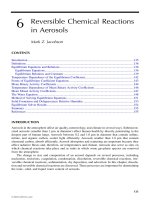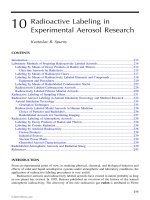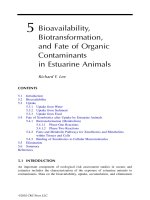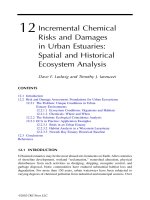Ecological Modeling in Risk Assessment - Chapter 5 docx
Bạn đang xem bản rút gọn của tài liệu. Xem và tải ngay bản đầy đủ của tài liệu tại đây (397 KB, 10 trang )
© 2002 by CRC Press LLC
CHAPTER 5
Population Models — Life History
Steve Carroll
Life-history models track characteristics of organisms as a function of age or stage. Stages can be
defined by size, morphological state, or any classifying variable deemed to be demographically
important. The most common characteristics that are tracked in such models are survival rates and
fecundities, collectively referred to as vital rates. The typical endpoints for life-history models are:
• Population abundance
• Abundances of individual age or stage classes
• Population growth rate or related parameters (e.g., sensitivity, elasticity)
Life-history models are important for several reasons. In many populations, survival probabil-
ities and fecundities vary among age or stage classes, and toxic chemicals may affect the various
classes differently. The predictions made on the basis of life-history models generally differ from
those made on the basis of simple population models in which individuals are assumed to be
identical. Life-history models allow the exploration of age-specific or stage-specific management
options.
For the purposes of this review, matrix models were classified into four categories, with the
last two representing software implementations of the first two (Table 5.1). These include:
• Deterministic age- or stage-based matrix models (Caswell 2001)
• Stochastic age- or stage-based matrix models (Caswell 2001)
• RAMAS
®
* Age, Stage, Metapop, or Ecotoxicology (Ferson 1993; Spencer and Ferson 1997b,c;
Applied Biomathematics 2000)
• ULM (unified life model) (Legendre and Clobert 1995)
For an in-depth treatment of matrix population models, see Caswell (2001). Density dependence,
or the lack thereof, is not explicit in this classification scheme. Thus, within a category, both density-
dependent and density-independent models are included.
DETERMINISTIC MATRIX MODELS (AGE OR STAGE BASED)
These models assume that survival rate and fecundity are functions of the age class or stage to
which an organism belongs. Age- and stage-structured models have been important tools in natural
* RAMAS is a registered trademark of Applied Biomathematics.
1574CH05.fm Page 55 Tuesday, November 26, 2002 4:55 PM
© 2002 by CRC Press LLC
Table 5.1 Internet Web Site Resources for Life-History Models
Model Name Description Reference Internet Web Site
Deterministic age- or
stage-based matrix
models
Life-history matrix models with fixed fecundity
and survivorship parameters
Caswell (2001)
leslie.html;
/>Stochastic age- or
stage-based matrix
models
Life-history matrix models incorporating random
variability in fecundity and survivorship
parameters
Caswell (2001) />RAMAS Age, Stage,
Metapop, or
Ecotoxicology
Software for life-history modeling of age- or
stage-structured populations
Ferson (1993); Spencer and Ferson
(1997b,c); Applied Biomathematics
(2000)
/>ULM (unified life model) Software for life-history modeling of age- or
stage-structured populations
Legendre and Clobert (1995) />-kassel.
de/model_db/mdb/ulm.html
1574CH05.fm Page 56 Tuesday, November 26, 2002 4:55 PM
© 2002 by CRC Press LLC
resource management, especially for fish, since the 1950s (Barnthouse 1998). The simplest life-
history model of this type is the Leslie population projection matrix (Leslie 1945):
N(t) = LN(t – 1)
where N(t) and N(t − 1) are vectors of the numbers of organisms in each age class (N
0
, . . . N
k
).
L =
where
s
k
= age-specific survivorship probability
f
k
= average fecundity at age k
Life stages, when not defined by age, are generally defined by size (height, weight, etc.) or
morphological state. Individuals within a given age class or stage are assumed to have identical
survival probabilities and fecundities. It is assumed that the vital rates do not vary as a result of
random environmental fluctuations or demographic stochasticity. Depending on whether or not
density dependence is included, the vital rates may vary (deterministically) as a function of
population size. The vital rates, which comprise the population matrix, can be obtained either from
laboratory experiments or from field observations.
Realism — HIGH — These models reflect that vital rates generally change with age. In many cases,
they incorporate all available demographic data because measures of variability in vital rates are
often unavailable. Within this category of models, age- or stage-structured models with density
dependence are more realistic than those without it.
Relevance — HIGH — Potential endpoints include expected population size (age specific), lambda
(the asymptotic population growth rate), or lambda-based measures such as sensitivity and elasticity.
All of these endpoints are relevant to ecotoxicological assessments. Survivorship and fecundity
parameters can be adjusted to reflect the effects of toxic chemicals observed in laboratory tests (e.g.,
Munns et al. 1997).
Flexibility — HIGH — All parameters are species-specific. The number of age classes, as well as the
vital rates, can vary among populations. Therefore, different population structures and life histories
can be modeled.
Treatment of Uncertainty — LOW — Neither environmental nor demographic stochasticity is incor-
porated in the basic approach. However, generalizations are being developed to deal with environ-
mental stochasticity (e.g., see below Stochastic Matrix Models and Caswell 2001).
Degree of Development and Consistency — HIGH — Several software programs implement this
model type, and documentation and technical support are available. Understanding the workings of
the model is relatively easy.
Ease of Estimating Parameters — MEDIUM — Parameters can in principle be obtained relatively
easily, either from laboratory experiments or from field observations. Alternatively, fecundity and
survivorship values may be approximated from standard survivorship and birth rate curves in the
literature. However, particularly when laboratory experiments are not appropriate or feasible, assess
-
ing the magnitude of chemical effects on each vital rate may be very difficult.
Regulatory Acceptance — HIGH — The model is being used by several regulatory agencies.
Credibility — HIGH — The model type is well known within academia. Many applications of the
model exist.
Resource Efficiency — HIGH — Application of the model requires no programming because software
is available. In many cases, available data are sufficient. However, when available data are not
sufficient, considerable effort may be needed to obtain new data.
1574CH05.fm Page 57 Tuesday, November 26, 2002 4:55 PM
sf sf sf s f 0
s0 0 0 0 0
0s 0 00
00s 00
000 s 0
01 02 23 k–1k
1
2
k
L
L
L
L
L
© 2002 by CRC Press LLC
STOCHASTIC MATRIX MODELS (AGE OR STAGE BASED)
Like the deterministic age- or stage-based matrix models, these models assume that survival rate
and fecundity are functions of the age class or stage in which an organism resides. In contrast with
their deterministic counterparts, the stochastic models incorporate environmental or demographic
stochasticity or both in the estimates of survival probabilities and fecundities (Caswell 2001).
Depending on whether density dependence is included, the vital rates may vary as a function of
population size. The vital rates, which comprise the population matrix, can be obtained either from
laboratory experiments or field observations.
Realism — HIGH — In addition to reflecting that vital rates generally change with age (or stage),
these models recognize that the rates may also vary as a result of random environmental fluctuations
and demographic stochasticity. They generally incorporate all available demographic data. Within
this category of models, age- or stage-structured models with density dependence are more realistic
than those without it.
Relevance — HIGH — Possible endpoints include expected population size (age- or stage-specific),
risk of decline, risk of extinction, and expected crossing time (the time at which the population is
expected to go either above or below a given size). These measures are all relevant to ecotoxicological
assessments. As the deterministic version of this model, the survivorship and fecundity values can
be adjusted to reflect the effects of toxic chemicals observed in laboratory tests.
Flexibility — HIGH — All parameters are species-specific. The number of age classes or stages, the
vital rates, and the variation in the vital rates can vary among populations. Therefore, different
population structures and life histories can be modeled.
Treatment of Uncertainty — HIGH — Both environmental and demographic stochasticity can be
incorporated.
Degree of Development and Consistency — HIGH — Several software programs implement this
model type, and documentation and technical support are available. It is relatively easy to understand
the workings of the model.
Ease of Estimating Parameters — MEDIUM — Required parameters include average vital rates and
their standard deviations. Furthermore, chemical impact on these parameters must be considered
(this can be handled, for example, by estimating two matrices — one with toxins and one without
toxins). Obtaining estimates of all such parameters can often be quite difficult. However, model
parameters are intuitive and can be interpreted biologically.
Regulatory Acceptance — HIGH — The model is used by several regulatory agencies.
Credibility — HIGH — The model is well known within academia. There are many applications of
the model.
Resource Efficiency — MEDIUM — Application of the model requires no programming, as software
is available. In some cases, data must be collected, but in many cases, available data are sufficient.
RAMAS AGE, STAGE, METAPOP, OR ECOTOXICOLOGY
These four computer programs (Spencer and Ferson 1997b; Ferson 1990; Ferson and Akçakaya
1988; Akçakaya 1998b) are collapsed into one category because they share a common source and
they receive the same ratings. Each program applies matrix models for age- or stage-structured
populations to estimate population-level parameters such as growth rate and extinction risk.
In RAMAS Ecotoxicology, a model of population dynamics and toxicant kinetics can be
constructed and linked to bioassay data. Using this program, a modeler can import data from
standard laboratory bioassays, incorporate these data into the parameters of a population model,
and perform a risk assessment by analyzing population-level differences between potentially
affected and control samples. The user specifies the control survivorship and fecundity for each
age class or stage. Density dependence in the form of ceiling, logistic, Ricker, or Beverton–Holt
functions can be added for specific age classes or stages. A user simulates toxic effects by selecting
1574CH05.fm Page 58 Tuesday, November 26, 2002 4:55 PM
© 2002 by CRC Press LLC
and parameterizing dose–response models (Weibull, probit, or logit) linked to survivorship and
fecundity values. Parameters can be specified as scalars, intervals, or distributions to account for
environmental variability and uncertainty. Monte Carlo simulations are then used to predict future
population trajectories and calculate the risk of adverse events such as extinctions or algal blooms.
The software checks the validity of the data input and model structure specified by the user.
Realism — HIGH — RAMAS Age models age-structured populations, and RAMAS Stage models
stage-structured populations. RAMAS Metapop can model either age-structured or stage-structured
populations. RAMAS Ecotoxicology can also model either age-structured or stage-structured pop
-
ulations and can also explicitly model the effects of toxic chemicals. All four programs can include
density dependence as well as environmental and demographic stochasticity.
Relevance — HIGH — Possible endpoints include expected population size (stage-specific), lambda,
lambda-based measures such as sensitivity and elasticity, risk of decline, risk of extinction, and
expected crossing time (the time at which the population is expected to exceed or to decrease to
less than a given size). These measures are all potentially useful in ecotoxicological assessments.
Effects of toxic chemicals are not explicitly modeled but can be incorporated by adjusting survivor
-
ship and fecundity values to reflect toxic effects (e.g., Munns et al. 1997).
Flexibility — HIGH — All parameters are species-specific. The number of age classes or stages, the
vital rates, and the variation in the vital rates can vary among populations. Therefore, different
population structures and life histories can be modeled. In RAMAS Ecotoxicology, different toxic
chemical dynamics and dose–response functions can be modeled.
Treatment of Uncertainty — HIGH — Both environmental and demographic stochasticity can be
incorporated.
Degree of Development and Consistency — HIGH — These models are easy to use and easy to apply
to different populations. Each program has a detailed user’s manual explaining the scientific basis
of the model as well as the capabilities of the program. The programs include several internal checks
for consistency.
Ease of Estimating Parameters — MEDIUM — Required parameters include vital rates at the very
least. In some cases, average vital rates and their standard deviations need to be estimated. Further
-
more, the chemical impact on these parameters may need to be considered (e.g., by choosing and
parameterizing a dose–response function or by estimating two matrices — one with toxins and one
without toxins). Obtaining estimates of all such parameters can often be quite difficult. Thus, ease
of parameter estimation varies among cases. However, model parameters are intuitive and can be
interpreted biologically.
Regulatory Acceptance — HIGH — These models are being used by several regulatory agencies.
Credibility — HIGH — These models are widely used within academia. Many applications of the
models exist.
Resource Efficiency — HIGH — No programming is necessary to use these programs. In some cases,
data must be collected, but in many cases, available data are sufficient.
UNIFIED LIFE MODEL (ULM)
ULM (Legendre and Clobert 1995) is a computer program that implements deterministic or
stochastic matrix models for analysis of population dynamics. ULM is somewhat similar to
RAMAS, except for its interface and varied capabilities. ULM accommodates a wide range of
populations with variable life-history characteristics. ULM can model any species life history as
a matrix model with or without density dependence, environmental stochasticity, demographic
stochasticity (as branching processes), inter- or intra-specific competition, parasitism, and metap
-
opulations. Results are expressed as population trajectories, distributions, growth rate, population
stage- or age-structure, generation times, sensitivities to changes in parameters, probability of
extinction, and extinction times. The stochastic models within ULM are implemented as Monte
Carlo simulations.
1574CH05.fm Page 59 Tuesday, November 26, 2002 4:55 PM
© 2002 by CRC Press LLC
Realism — HIGH — ULM models age-structured and stage-structured populations. The number of
age classes or stages is variable. Environmental stochasticity is included.
Relevance — HIGH — Possible endpoints include expected population size (age- or stage-specific),
lambda, lambda-based measures such as sensitivity and elasticity, and risk of extinction. These
measures are all used in ecotoxicological assessments.
Flexibility — HIGH — All parameters are species-specific. The number of age classes or stages, the
vital rates, and the variation in the vital rates can vary among populations. Therefore, different
population structures and life histories can be modeled.
Treatment of Uncertainty — HIGH — Environmental stochasticity can be incorporated.
Degree of Development and Consistency — MEDIUM — Some programming is required to use the
model. This programming must use a language defined by the authors of the program. Legendre
and Clobert (1995) explain the use of the model and provide examples.
Ease of Estimating Parameters — HIGH — Parameters can be obtained relatively easily, either from
laboratory experiments or field observations.
Regulatory Acceptance — LOW — No information on the model’s regulatory acceptance is available.
The model is not likely to be used by a regulatory agency at present because programming is required
to use the model.
Credibility — MEDIUM — Several (approximately 20) publications apply the model to different cases.
Resource Efficiency — MEDIUM — Some programming is necessary to use this program. In some
cases, data must be collected, but in many cases available data are sufficient.
DISCUSSION AND RECOMMENDATIONS
Life-history models (Table 5.2) are well developed and are already being used for ecotoxicological
assessment (Levin et al. 1996; Munns et al. 1997; Crutchfield and Ferson 2000) (Table 5.3; also
see Barnthouse [1993] for a review of other applications). These models have already been gener
-
alized to be spatially explicit within a metapopulation framework (RAMAS Metapop) and to
explicitly include the dynamics and effects of toxic chemicals (RAMAS Ecotoxicology). Deter
-
ministic and stochastic matrix models and RAMAS Age, Stage, Metapop, or Ecotoxicology are
therefore recommended for further evaluation and use in chemical risk assessment. Suggested future
developments include development of software that includes both spatially explicit effects and the
dynamics/effects of toxic chemicals. Software should be developed for calculating risk-based
(probabilistic) sensitivities with respect to vital rates to answer questions such as How does the
probability of decline change as a result of changes in the vital rates? This method would be an
adaptation of the results of Uryasev (1995). This development would allow the conversion of
sensitivity-based methods, such as decomposition of the change in lambda, into the language of
risk. Such sensitivity-based applications are used to identify age-specific or stage-specific manage
-
ment strategies. The new methods will generalize widely used methods of lambda decomposition
(Caswell 2001).
1574CH05.fm Page 60 Tuesday, November 26, 2002 4:55 PM
© 2002 by CRC Press LLC
Table 5.2 Evaluation of Population Models — Life History Models
Evaluation Criteria
Model Reference Realism Relevance Flexibility
Treatment
of
Uncertainty
Degree of
Development
Ease of
Estimating
Parameters
Regulatory
Acceptance
Credibility
Resource
Efficiency
Deterministic age- or
stage-based matrix
Caswell (2001) ◆◆◆ ◆◆◆ ◆◆◆ ◆ ◆◆◆ ◆◆ ◆◆◆ ◆◆◆ ◆◆◆
Stochastic age- or
stage-based matrix
Caswell (2001) ◆◆◆ ◆◆◆ ◆◆◆ ◆◆◆ ◆◆◆ ◆◆ ◆◆◆ ◆◆◆ ◆◆
RAMAS Age, Stage,
Metapop, or
Ecotoxicology
Ferson (1993);
Spencer and Ferson
(1997c); Applied
Biomathematics
(2000)
◆◆◆ ◆◆◆ ◆◆◆ ◆◆◆ ◆◆◆ ◆◆ ◆◆◆ ◆◆◆ ◆◆◆
Unified life model
(ULM)
Legendre and Clobert
(1995)
◆◆◆ ◆◆◆ ◆◆◆ ◆◆◆ ◆◆ ◆◆◆ ◆ ◆◆ ◆◆
Note: ◆◆◆ - high
◆◆ - medium
◆ - low
1574CH05.fm Page 61 Tuesday, November 26, 2002 4:55 PM
© 2002 by CRC Press LLC
Table 5.3 Applications of Life-History Models
Model Species Location/Population Reference
Deterministic age-based matrix Burrowing mayflies,
Hexagenia spp.
(H. limbata and
H. rigida)
Western Lake Erie Madenjian et al.
(1998)
Subtidal snail
(Umbonium costatum)
Hakodate Bay,
northern Japan
Noda and Nakao
(1996)
Mysid (Americamysis
bahia)
Laboratory Kuhn et al. (2000)
Pea aphid
(Acyrthosiphon pisum)
Laboratory Walthall and Stark
(1997)
Northern sea lions
(Eumetopias jubatus)
Marmot Island,
Alaska
York (1994)
Deterministic age-based matrix and
deterministic stage-based matrix
Polychaetes (Capitella
sp. I and Streblospio
benedicti)
Estuaries and littoral
wetlands throughout
much of the United
States
Levin et al. (1996)
Deterministic stage-based matrix Pea aphid
(Aeyrthosiphon pisum)
Laboratory Stark and
Wennergren (1995)
Soil mite (Platynothrus
peltifer
), isopod
(Porcellio scaber), and
nematode (Plectus
acuminatus)
Laboratory Kammenga et al.
(2001)
Bluegill sunfish
(Lepomis
macrochirus)
Generic lake in central
Florida
Bartell et al. (2000)
Brook trout (Salvelinus
fontinalis)
Southern
Appalachian
mountain streams
Marschall and
Crowder (1996)
Estuarine fish
(Fundulus
heteroclitus)
New Bedford Harbor,
Massachusetts
Munns et al. (1997)
Loggerhead sea turtles
(Caretta caretta)
Trawl fisheries of the
southeastern United
States
Crowder et al. (1994)
Yellow mud turtles
(Kinosternon
flavescens) and
Kemp's ridley sea
turtles (Lepidochelys
kempi)
Texa s Heppell et al. (1996)
Killer whales (Orcinus
orca)
Pacific Northwest Brault and Caswell
(1993)
Savannah grass
(Andropogon
brevifolius Schwarz)
Venezuelan savannas Canales et al. (1994)
Deterministic stage-based matrix and
stochastic stage-based matrix
Snail kite (Rostrhamus
sociabilis)
Everglades Beissinger (1995)
House sparrow (Passer
domesticus)
India, Pakistan Slade (1994)
Steller sea lion
(Eumetopias jubatus)
Northeast Pacific Pascual and Adkinson
(1994)
American ginseng
(Panax quinquefolium)
and wild leek (Allium
tricoccum)
Canada Nantel et al. (1996)
Mountain golden
heather (Hudsonia
montana)
North Carolina Gross et al. (1998)
Stochastic age-based matrix Brook trout (Salvelinus
fontinalis)
Montmorency County,
Michigan
McFadden et al.
(1967)
Striped bass (Morone
saxatilis)
Potomac River Cohen et al. (1983)
1574CH05.fm Page 62 Tuesday, November 26, 2002 4:55 PM
© 2002 by CRC Press LLC
Table 5.3 (cont.)
Hawaiian stilt
(Himantopus
mexicanus knudseni)
Hawaii Reed et al. (1998)
Mediterranean monk
seal (Monachus
monachus)
Atlantic Ocean (North
Africa) and eastern
Mediterranean
Durant and Harwood
(1992)
Roan antelope
(Hippotragus equinus)
Parc National de
l'Akagera in Rwanda
Beudels et al. (1992)
Asiatic wild ass (Equus
hemionus)
Negev Desert of
southern Israel
Solbreck (1991); Saltz
and Rubenstein
(1995)
African elephant
(Loxodonta africana)
Tsavo National Park,
Kenya
Armbruster and
Lande (1993)
Stochastic stage-based matrix Algae (Ascophyllum
nodosum)
Swedish coast Aberg (1992)
Marine bivalve (Yoldia
notabilis)
Otsuchi Bay,
northeastern Japan
Nakaoka (1997)
Sea whip coral
(Leptogorgia virgulata)
Northeastern Gulf of
Mexico
Gotelli (1991)
Grey seal (Halichoerus
grypus) and ringed
seal (Phoca hispida)
Baltic Sea Kokko et al. (1997)
Desert tortoise
(Gopherus agassiz)
Western Mojave
Desert
Doak et al. (1994)
Red deer (Cervus
elaphus)
Rum, Western Isles,
Scotland
Benton et al. (1995)
Redwood (Sequoia
sempervirens)
California, Oregon Namkoong and
Roberds (1974)
RAMAS Age Bluegill (Lepomis
machrochirus)
Hyco Reservoir, North
Carolina
Crutchfield and
Ferson (2000)
Striped bass (Morone
saxatilis)
Santee-Cooper
system, South
Carolina
Bulak et al. (1995)
Cod Atlantic Ginzburg et al. (1990)
Marbled murrelet
(Brachyramphus
marmoratus)
Oregon Oregon Department
of Fish and Wildlife
(1995)
RAMAS Ecotoxicology Brook trout (Salvelinus
fontinalis)
Montmorency County,
Michigan
Spencer and Ferson
(1997b)
Lesser kestrel (Falco
naumanni)
Southern Spain Spencer and Ferson
(1997b)
Moose (Alces alces
gigas)
Northeastern Alberta Spencer and Ferson
(1997b)
RAMAS Stage Giant kelp (Macrocystis
pyrifera)
Southern California
coastal waters
Burgman and Gerard
(1989)
Bluegill sunfish
(Lepomis
macrochirus)
North Carolina Crutchfield and
Ferson (2000)
Threadfin shad
(Dorosoma
petenense)
South Carolina Barwick et al. (1994)
Red-cockaded
woodpecker (Picoides
borealis)
Georgia Piedmont Maguire et al. (1995)
Bradshaw’s lomatinum
(Lomatium
bradshawii)
Western Oregon Kaye et al. (1994)
Sentry milk-vetch
(Astragalus
cremnophylax)
Grand Canyon
National Park,
Arizona
Maschinsky et al.
(1997)
ULM — stochastic stage-based
matrix
Grey partridge (Perdix
perdix)
Northwest and
southeast France
Bro et al. (2000)
1574CH05.fm Page 63 Tuesday, November 26, 2002 4:55 PM
© 2002 by CRC Press LLC
Table 5.3 (cont.)
Model Species Location/Population Reference
ULM — deterministic stage-based
matrix
Yellow-legged gull
(Larus cachinnans)
Medes Islands,
northwestern
Mediterranean
Bosch et al. (2000)
ULM — stochastic stage-based
matrix
Passerine songbirds User defined Legendre (1999)
ULM — deterministic stage-based
matrix and stochastic stage-based
matrix
Snake (Vipera ursinii
ursinii) and raptor
(Gyps fulvus fulvus)
User defined Ferriere et al. (1996)
1574CH05.fm Page 64 Tuesday, November 26, 2002 4:55 PM









